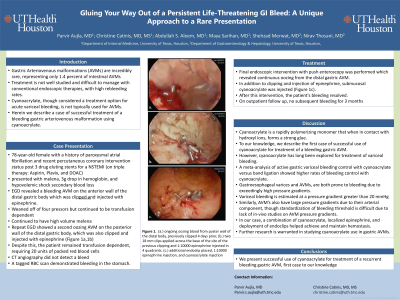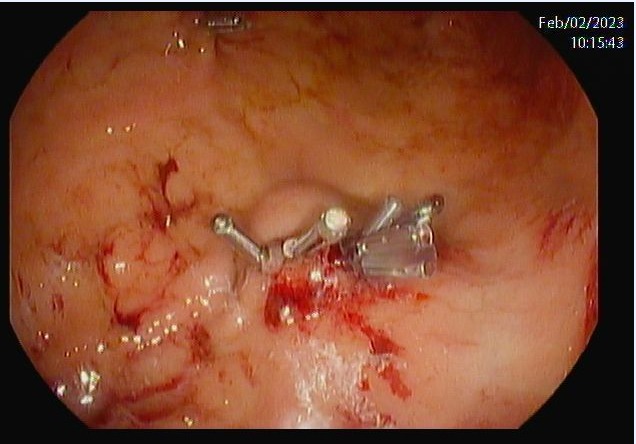Sunday Poster Session
Category: GI Bleeding
P0662 - Gluing Your Way Out of a Persistent Life-Threatening GI Bleed: A Unique Approach to a Rare Presentation
Sunday, October 22, 2023
3:30 PM - 7:00 PM PT
Location: Exhibit Hall

Has Audio

Parvir Aujla, MD
University of Texas Health Science Center
Houston, TX
Presenting Author(s)
Parvir Aujla, MD1, Christine Catinis, MD, MS2, Abdullah Aleem, MD3, Maya Sarihan, MD2, Shehzad Merwat, MD4, Nirav Thosani, MD5
1University of Texas Health Science Center, Houston, TX; 2University of Texas Health Science Center at Houston, Houston, TX; 3University of Texas Health Science Center, Houston, AZ; 4University of Texas, Houston, TX; 5McGovern Medical School at UTHealth, Houston, TX
Introduction: Gastric Arteriovenous malformations (AVMs) are incredibly rare, representing only 1.4 percent of intestinal AVMs. Treatment is not well studied and difficult to manage with conventional endoscopic therapies, with high rebleeding rates. Cyanoacrylate, though considered a treatment option for acute variceal bleeding, is not typically used for AVMs. Herein we describe a case of successful treatment of a bleeding gastric arteriovenous malformation using cyanoacrylate.
Case Description/Methods: A 78-year-old female with a history of cardiac stents on triple therapy presented with melena and 3g drop in hemoglobin. EGD revealed a bleeding AVM on the anterior wall of the distal gastric body which was clipped and injected with epinephrine. The patient continued to have high volume melena, and a tagged RBC scan demonstrated bleeding in the stomach. Repeat EGD showed a second oozing AVM on the posterior wall of the distal gastric body, which was also clipped and injected with epinephrine. Despite this, the patient remained transfusion dependent, so a final endoscopic intervention with push enteroscopy was performed which revealed continuous oozing from the distal gastric AVM. This time, in addition to clipping and injection of epinephrine, submucosal cyanoacrylate was injected (Figure 1). After this intervention, the patient's bleeding resolved.
Discussion: Cyanoacrylate is a rapidly polymerizing monomer that when in contact with hydroxyl ions, forms a strong glue. To our knowledge, we describe the first case of successful use of cyanoacrylate for treatment of a bleeding gastric AVM. However, cyanoacrylate has long been explored for treatment of variceal bleeding. A meta-analysis of active gastric variceal bleeding control with cyanoacrylate versus band ligation showed higher rates of bleeding control with cyanoacrylate. Gastroesophageal varices and AVMs, are both prone to bleeding due to exceedingly high pressure gradients. Though venous structures, variceal bleeding is estimated at a pressure gradient greater than 20 mmHg, similarly, AVM’s also have large pressure gradients due to their arterial component, though standardization of bleeding threshold is difficult due to lack of in-vivo studies on AVM pressure gradients. In our case, a combination of cyanoacrylate, localized epinephrine, and deployment of endoclips helped achieve and maintain hemostasis. Further research is warranted in studying cyanoacrylate use in gastric AVMs.

Disclosures:
Parvir Aujla, MD1, Christine Catinis, MD, MS2, Abdullah Aleem, MD3, Maya Sarihan, MD2, Shehzad Merwat, MD4, Nirav Thosani, MD5. P0662 - Gluing Your Way Out of a Persistent Life-Threatening GI Bleed: A Unique Approach to a Rare Presentation, ACG 2023 Annual Scientific Meeting Abstracts. Vancouver, BC, Canada: American College of Gastroenterology.
1University of Texas Health Science Center, Houston, TX; 2University of Texas Health Science Center at Houston, Houston, TX; 3University of Texas Health Science Center, Houston, AZ; 4University of Texas, Houston, TX; 5McGovern Medical School at UTHealth, Houston, TX
Introduction: Gastric Arteriovenous malformations (AVMs) are incredibly rare, representing only 1.4 percent of intestinal AVMs. Treatment is not well studied and difficult to manage with conventional endoscopic therapies, with high rebleeding rates. Cyanoacrylate, though considered a treatment option for acute variceal bleeding, is not typically used for AVMs. Herein we describe a case of successful treatment of a bleeding gastric arteriovenous malformation using cyanoacrylate.
Case Description/Methods: A 78-year-old female with a history of cardiac stents on triple therapy presented with melena and 3g drop in hemoglobin. EGD revealed a bleeding AVM on the anterior wall of the distal gastric body which was clipped and injected with epinephrine. The patient continued to have high volume melena, and a tagged RBC scan demonstrated bleeding in the stomach. Repeat EGD showed a second oozing AVM on the posterior wall of the distal gastric body, which was also clipped and injected with epinephrine. Despite this, the patient remained transfusion dependent, so a final endoscopic intervention with push enteroscopy was performed which revealed continuous oozing from the distal gastric AVM. This time, in addition to clipping and injection of epinephrine, submucosal cyanoacrylate was injected (Figure 1). After this intervention, the patient's bleeding resolved.
Discussion: Cyanoacrylate is a rapidly polymerizing monomer that when in contact with hydroxyl ions, forms a strong glue. To our knowledge, we describe the first case of successful use of cyanoacrylate for treatment of a bleeding gastric AVM. However, cyanoacrylate has long been explored for treatment of variceal bleeding. A meta-analysis of active gastric variceal bleeding control with cyanoacrylate versus band ligation showed higher rates of bleeding control with cyanoacrylate. Gastroesophageal varices and AVMs, are both prone to bleeding due to exceedingly high pressure gradients. Though venous structures, variceal bleeding is estimated at a pressure gradient greater than 20 mmHg, similarly, AVM’s also have large pressure gradients due to their arterial component, though standardization of bleeding threshold is difficult due to lack of in-vivo studies on AVM pressure gradients. In our case, a combination of cyanoacrylate, localized epinephrine, and deployment of endoclips helped achieve and maintain hemostasis. Further research is warranted in studying cyanoacrylate use in gastric AVMs.

Figure: Figure 1: Gastric arteriovenous malformation status post endoclipping, epinephrine injection, and submucosal cyanoacrylate
Disclosures:
Parvir Aujla indicated no relevant financial relationships.
Christine Catinis indicated no relevant financial relationships.
Abdullah Aleem indicated no relevant financial relationships.
Maya Sarihan indicated no relevant financial relationships.
Shehzad Merwat indicated no relevant financial relationships.
Nirav Thosani: Abbvie – Consultant. Boston Scientific Corp – Consultant. Pentax America – Consultant. ROSEAID inc – Creatorship rights.
Parvir Aujla, MD1, Christine Catinis, MD, MS2, Abdullah Aleem, MD3, Maya Sarihan, MD2, Shehzad Merwat, MD4, Nirav Thosani, MD5. P0662 - Gluing Your Way Out of a Persistent Life-Threatening GI Bleed: A Unique Approach to a Rare Presentation, ACG 2023 Annual Scientific Meeting Abstracts. Vancouver, BC, Canada: American College of Gastroenterology.
